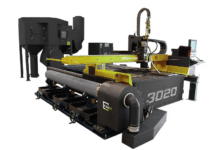
REP International, long acknowledged as the world leader in injection and other molding presses for rubber and TPE, has announced that a strong increase in sales and continued technology developments were realized in 2014.
An outstanding year 2014
During the past fiscal year, REP registered strong growth in sales and made many investments. Industrial logistic developments were consummated, with the launch of production facilities in India (RPE India) and China (URP Machinery) as well as the development of new machines specially designed to better match emerging Asian market requirements. According to Tim Graham, president of REP Corporation, the North American affiliate, efforts will be pursued in 2015 in these countries, while the development of the G10 range of rubber injection molding machines, the focus segment of the REP brand in Western markets, will continue. A G10 machine will be displayed to the North American market at this year’s Rubber Expo in Cleveland, Ohio.
The company’s internal data confirm that REP presses are mainly used for producing automotive anti-vibration systems and sealing applications, with this sector alone registering a 34% global increase in 2014 sales. Also noteworthy was the increasing demand for bi-material presses, which contributed to a new press technology, available only from REP presently, namely, the dual-compound CMS injection machine.
A multi-station bi-material injection molding press
The dual-compound CMS machine is today a standard injection press with four rotating stations and two injection units allowing for the synchronous curing, stripping and injection of two compounds into the same mold.
Equipping an injection molding machine with a second injection unit has been a viable production technology for REP on all types of machines in all configurations, dating back to the G7 generation. These include injection from the top or the bottom, the back or the side etc. In this way, REP can respond to its customer’s most complex requirements for production and factory footprint, according to Graham.
The goal with this new technology is the combinination of technical performance at optimized cost. The elimination of secondary assembly operations and integration of a low-cost compound into a part are thereby achieved, thus limiting the quantity of higher performing and higher cost compound only to the functional sections of the molded part.
The production of dual-compound parts may be performed on a CMS press using:
- Two sequential injections into two complementary cavities
- Simultaneous injection into two different cavities or into two separate part cavities
- Simultaneous (or offset) injection into one single cavity
It is also possible to directly inject into the mold or through a special cold runner block (CRB), integrating several compound circuits. This dual-compound injection principle can be adapted to all injection presses, regardless of the size of the closing units and injection units.
Increased Productivity and Flexibility
By equipping the standard CMS for the first time with a second injection unit, REP provides its customers optimized productivity and maximum flexibility. Tim Graham notes, “We especially want to emphasize that a CMS press – thanks to its four molds – allows for a much higher hourly production rate, which means a gain in productivity of 50% to 100% typically, compared to a single-station press of 400 tons, for example.”
Further noting the flexibility, Graham adds that the CMS is characterized by quick mold changes (10 minutes on average for the 4 molds), plus the possible de-selection of one mold, the programming of different injection volumes and the adaptation of the stripping station to various production requirements, all through pre-programmed control of the cycles. The dual-compound CMS press is not only dedicated to dual-compound injection, however. Users can also switch from simultaneous injection to sequential injection, or only use an injection unit, as needed, on a particular cycle.
Using exclusive REP technology
The CMS machine further allows for enhanced productivity by limiting the number of cavities per mold, thus leading to a better control of the material flow inside the cavity. As a multi-station and multi-injection machine, the dual-compound CMS thereby utilizes unique REP technology to benefit its customers in various applications and production scenarios. Graham concludes, “We are very excited by possibilities of this machine and the first users globally have reported very positive results.”
In the first half of 2015, REP International will exhibit at the following fairs and shows: Tires & Rubber in Moscow, ElmiaPolymer in Sweden, Plast 2015 in Milan and DKT/IRC in Nuremberg.
For more information, please visit:
www.repinjection.com
Or contact:
tgraham@repcorp.com | Tim Graham, President



















